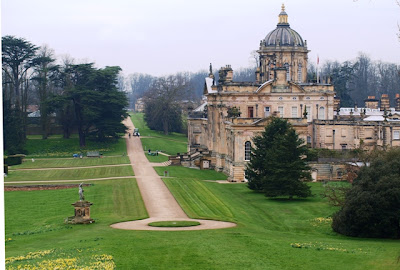Castle Howard visited by Geordie Professor
Visited, not revisited, unlike Brideshead. This week I made my first visit to Castle Howard, in North Yorkshire, the setting for much of ITV's 1981 memorable television adaptation of Brideshead Revisited. And on returning to Kew I get a letter saying I am soon to be a Geordie Professor.
I was a big Evelyn Waugh fan in my youth (i.e. leading up to this adaptation...) so this was a poignant visit. That said, I didn't make it inside the home. I was there to see the arboretum and rhododendron garden, both holding plants from the Royal Botanic Gardens, Kew collections. The trip with Tony Kirkham, Head of Arboriculture and Horticultural Services (as well as TV personality, as evidenced by an excited interruption during our breakfast) was part of my induction as a new member of the Castle Howard Arboretum Trust Board.
The owner of Castle Howard, Hon. Simon Howard, and the Chairman of the Board, Alastair Fitter, joined Tony, me and some of the staff and volunteers for a brisk walk through the skeletal winter trees. The arboretum includes a rich collection of temperate trees, many of them difficult to grow at Kew Gardens due to its poor soil and slightly drier climate.
In fact Castle Howard, along with the Millennium Seed Bank and various other plant sharing arrangements, is part of the insurance policy for our living collection. Castle Howard is also able to grow more duplicates of each species or cultivar, providing a better conservation and scientific collection in some cases, often from multiple gatherings or locations.
There is more on the history of Castle Howard and its relationship with Kew on our website, and on theirs. Castle Howard, situated near York in North Yorkshire, is an 18th-century residence set within 1,000 acres of pretty amazing landscape - large lakes, sweeping lawns, various follies and sculptures, not to mention the gardens and arboretum.
The Castle Howard Arboretum Trust was formed in 1996 and since then Kew has been working with the management and staff there to increase the diversity of the accessions and plan for its development as a visitor attraction and botanical collection.
Jim Russell, from a well known family of nurserymen in the UK, became head gardener at Howard Castle in 1970. He began the quest to create a collection of rare trees and shrubs in Ray Wood – a densely planted naturalistic garden near the home - and then later the Arboretum.Russell was a close friend of John Simmons, Curator of Kew Gardens until 1995. Both of them loved collecting and between them introduced lots of wild-collected (and well documented) plants into cultivation.
Today the Arboretum is taking shape, literally. Now that the trees are 30-40 years old the structure of the Arboretum is clear and the foresight to leave broad vistas recognised. On my visit there were few leaves and flowers but the structure of the collection, the winter bark and the occasional early bloom made it worthwhile.
Ray Wood is quite different. On my visit I could enjoy the results of recent pruning and canopy thinning, allowing the plants to breathe a little, but even so it is a far denser planting than over in the arboretum. Most of the shrubs are rhododendrons, some with pedigrees back to Joseph Hooker collections. There are few species collected for Kew but no longer growing there.
All up, a lovely day in a lovely part of the country. I arrived back to get confirmation that I've been made a Visiting Professor in the School of Biological and Biomedical Sciences at Durham University (as of 1 May). Durham is in the county just north of North Yorkshire. So I now feel very much part of the North of England (the birthplace of my mother's father - just north of Newcastle - and on the east side, the source of the 'Entwisle' name). You may notice a little Geordie accent next time I return to Australia.









Comments